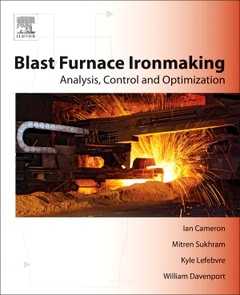Description
Blast Furnace Ironmaking
Analysis, Control, and Optimization
Authors: Cameron Ian, Sukhram Mitren, Lefebvre Kyle, Davenport William
Language: English
Subjects for Blast Furnace Ironmaking:
Keywords
Iron blast furnace; molten steel; molten iron; Blast furnace mathematical description; mass and enthalpy balance equations; Blast Furnace Model; Raceway Calculations; Charge Level Calculations; Slag Chemistry; Flux Requirements; Molten Iron Composition; Blast Furnace Design; Metallurgical Coke; Ore; Ore Pellets and Ore Sinter; Blast Furnace Stoves
213.03 €
In Print (Delivery period: 14 days).
Add to cart828 p. · 19x23.3 cm · Paperback
Description
/li>Contents
/li>Readership
/li>Biography
/li>Comment
/li>
Blast Furnace Ironmaking: Analysis, Control, and Optimization uses a fundamental first principles approach to prepare a blast furnace mass and energy balance in Excel?. Robust descriptions of the main equipment and systems, process technologies, and best practices used in a modern blast furnace plant are detailed. Optimization tools are provided to help the reader find the best blast furnace fuel mix and related costs, maximize output, or evaluate other operational strategies using the Excel? model that the reader will develop.
The first principles blast furnace Excel? model allows for more comprehensive process assessments than the 'rules of thumb' currently used by the industry. This book is suitable for undergraduate and postgraduate science and engineering students in the fields of chemical, mechanical, metallurgical and materials engineering. Additionally, steel company engineers, process technologists, and management will find this book useful with its fundamental approach, best practices description, and perspective on the future.
1. The iron blast furnace process2. Inside the blast furnace3. Making steel from molten blast furnace iron4. Introduction to the blast furnace mass balance5. Introduction to the blast furnace enthalpy balance6. Combining mass and enthalpy balance equations7. Conceptual division of the blast furnace - bottom segment calculations8. Bottom segment with pulverized carbon injection9. Bottom segment with oxygen enrichment of blast air10. Bottom segment with low purity oxygen enrichment11. Bottom segment with CH4(g) injection12. Bottom segment with moisture in blast air13. Bottom segment with pulverized hydrocarbon injection14. Raceway flame temperature15. Automating matrix calculations16. Raceway flame temperature with pulverized carbon injection17. Raceway flame temperature with oxygen enrichment18. Raceway flame temperature with CH4(g) injection19. Raceway flame temperature with moisture in blast air20. Top segment mass balance21. Top segment enthalpy balance22. Top gas temperature calculation23. Top segment calculations with pulverized carbon injection24. Top segment calculations with oxygen enrichment 25. Top segment mass balance with CH4(g) injection26. Top segment enthalpy balance with CH4 injection27. Top gas temperature with CH4 injection28. Top segment calculations with moisture in blast air29. Bottom segment calculations with natural gas injection30. Raceway flame temperature with CH4(g) injection31. Top segment calculations with natural gas injection32. Bottom segment slag calculations – Ore, fluxes, and slag33. Bottom segment slag calculations – With excess Al2O3 in ore34. Bottom segment slag calculations35. Bottom segment calculations - Reduction of SiO236. Bottom segment calculations - Reduction of MnO37. Bottom segment calculations with pulverized coal injection38. Bottom segment calculations with multiple injectants39. Raceway flame temperature with multiple injectants40. Top segment calculations with multiple injectants41. Top segment calculations with raw material moisture42. Top segment with carbonate fluxes43. Top charged steel scrap44. Top charged direct reduced iron45. Bottom segment calculations with H2(g) injection46. Top segment calculations with H2(g) injection47. CO(g) injection into bottom and top segments48. Introduction to blast furnace optimization49. Blast furnace optimization case studies50. Blast furnace rules of thumb51. The blast furnace plant52. Blast furnace proper53. Blast furnace refractory inspection technologies54. Blast furnace ferrous burden preparation55. Metallurgical coke – A key to blast furnace operations56. Blast furnace fuel injection57. Casting the blast furnace58. Blast furnace slag59. Burden distribution
chemical and metallurgical engineering (main market China and other developed countries around the world) senior undergraduates science and engineering students and post-graduate students. Engineers and scientists in industries that produce and/or use iron and steel. Policy makers in industry and government and because it points the way to 'green' production of iron and steel. Also suppliers to the global steel industry
Dr. Mitren Sukhram is a senior process engineer in the Pyrometallurgy Sector Practice at Hatch Ltd. He works on all aspects of blast furnace ironmaking including reline planning, techno-economic assessments, campaign life assessment/extension, and operational support for blast furnaces located around the world. More recently, Mitren has focused on developing innovative technologies to improve blast furnace productivity and reduce greenhouse gas emissions. Mitren is a graduate from the University of Toronto, Toronto, Canada where he completed Bachelor, Master’s and PhD degrees in Material Science and Engineering. In his PhD studies, Mitren developed a novel sensor that measured velocity patterns in liquid metals. His areas of expertise include thermodynamics, heat, mass, and momentum transfer in pyrometallurgical processes. Mitren is a licensed Professional Engineer in Ontario, Canada.
Kyle Lefebvre is a process engineer in the Pyrometallurgy practice at Hatch Ltd. His work includes
- Provides sample problems, answers and assignments for each chapter
- Explores how to optimize the blast furnace operation while maintaining required temperatures and gas flowrates
- Describes all major blast furnace equipment and best practices
- Features blast furnace operating data from five continents



